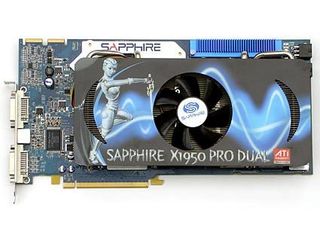CrossFire-on-a-Stick
Final Thoughts

For a near retail version of this product I for one am impressed. Peering into the potential of more than one processor on a card for CrossFire is something that is something I wish ATI/AMD would have tried. Perhaps they might have but it would have been great to see the performance and struggles even if it would have been only on engineering samples.
Direct3D 10 or not, the possibility for 32 devices in a system makes for a super computer of a rendering monster. Based on the architecture, the compositing engine is embedded into the core of the graphics processor. The approach ATI took building CrossFire actually should yield more performance than SLI and Quad SLI. In a regular rendering path in modes such as Split Frame Rendering (SFR), the first processor does half of the frame and the second does the other half. Nvidia's version needs a second cycle to put both frames together inside the "master" GPU.
ATI/AMD does not need a graphics processor to put the data together. Instead, the compositing chip takes the output information and does a simple memory copy. Part 1 and part 2 are simply spliced together and placed on the front buffer. The compositing engine can even do a blend when Super AA and other tasks need to blend parts of the data at the edge of the copied edges. Therefore, when Nvidia is taking a second cycle to piece the image data together, ATI's solution is working on the next frame. However, only time will tell if this is merely theoretical or actually the case with results to prove it.
Looking at this card it would only make sense if Sapphire sticks to its preliminary pricing schedule of $300-350. R600 is due to hit next month and Nvidia is planning the next range of cards between now and R600. The possibility of being able to hook up two cards in a "QuadFire" configuration would be cool. I hope Sapphire can get it working or even better, I hope that AMD would choose to help support it.
Yes it has its problems in its current form but overall I am impressed with the card because it is an attempt to do something "outside the box." The bleeding edge is never without some cuts and bruises. One cannot expect everything to work the way you want it too when the theoretical touches the practical. Even if this card never sees four graphics cores acting as one, having one of these cards in your box can drive four monitors and would be more than "Vista Ready" with VIVO capacities. I am tempted to try a game like Microsoft's Flight Simulator to see if it can drive all of the displays for the surround cockpit view. I look forward to seeing the retail version and if the support comes... who knows, it could be the coolest thing for a decent price.
Join our discussion on this topic
Stay on the Cutting Edge
Join the experts who read Tom's Hardware for the inside track on enthusiast PC tech news — and have for over 25 years. We'll send breaking news and in-depth reviews of CPUs, GPUs, AI, maker hardware and more straight to your inbox.
Most Popular

